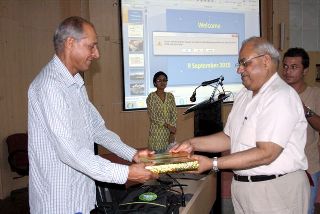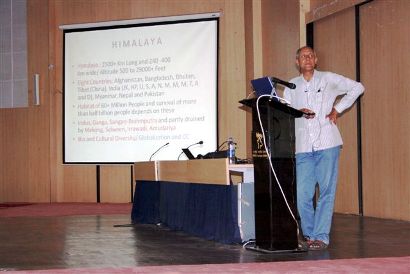Himalaya Day celebrated at the Wildlife Institute of India, Dehradun, 9th September 2015.
|
Dr. V. B. Mathur, Director, Wildlife Institute of India, Dehradun, stated that the institute has been observing the Himalaya Day every year since 2011 and for this year we had invited Prof. Shekhar Pathak, a noted historian, writer, orator and naturalist for talk on 'Kailash- Manas Prakruti and Sanskriti" at the institute. The talk was held in WII Auditorium which was attend by all employees participated. Dr. Shekhar Pathak is an Indian historian, writer and academician from Uttarakhand. He is a former professor of History at Kumaun University, Nainital and a Nehru Fellow at the Centre for Contemporary Studies at Teen Murti in New Delhi. He was awarded the Padma Shri by Govt. of India, in 2007. In his elaborate talk, he mentioned about ‘Kailash-Mansarovar Yatra’ and the natural and cultural values of this landscape. Holding significance for the Hindus as the abode of Lord Shiva, it holds religious importance also for the Jains and the Buddhists. Three of the world's major rivers—the Indus, the Ganges and the Brahmaputra—arise in the Himalayas. While the Indus and the Brahmaputra rise near Mount Kailash in Tibet, the Ganges rises in the Indian state of Uttarakhand. Their combined drainage basin is home to some 600 million people. The indigenous people living in eastern Uttarakhand, western Nepal and southern Tibet and the rich and diverse flora and fauna are all an integral part of this landscape that needs to be conserved and managed through trans-boundary cooperation. Taking this into consideration, the governments of India, China and Nepal have come together to work towards the common conservation and sustainable development goals in the Kailash Sacred Landscape that is coordinated by ICIMOD said Dr. P.K. Mathur, Dean, WII The unique floral and faunal wealth of the Himalayas is undergoing structural and compositional changes due to climate change. The increase in temperature is shifting various species to higher elevations. There are reports of early flowering and fruiting in some plant species said Dr. G.S. Rawat, Senior Scientist, WII. These facts reflect that the Himalayas have been soul of the country by virtue of cultural, ethnic, ecological and economical values. It has not been guarding country’s border only but constantly serving its human by enriching soil, air, water etc. Unfortunately importance of Himalayas was always underestimated for its integral role in overall development of the Nation. Deterioration of Himalayan system due to inadequate attention has threatened our Life Supporting Resources. Status of forest, water, air soil has become alarmingly grim. But, we must not forget that the Himalayas are our greatest heritage. They are storehouses of biodiversity and natural resources which have sustained life in the mountains as well as the plains for centuries. “From time immemorial, Himalaya is the sacred place for all the communities living in Gangetic plains and Tibetan plateau. About 60 million people depend on Himalaya for their day-to-day activities and livelihoods. The diversity of life as well as human communities are unique in Himalaya. In this era of rapid transformation, we need to understand and mitigate the loss of Himalayan ecosystem.” told by Prof. Pathak in his elaborate talk. The Himalayan states and its people definitely need economic growth, but the planners and policy makers in New Delhi and the state capitals of the Himalayan states should take special care that development and economic growth takes into account the ecology and the fragility of the region. |
  |
Last Updated: September 11, 2015










